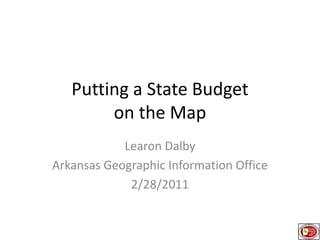Putting a State Budget on a Map
- 1. Putting a State Budget on the MapLearon DalbyArkansas Geographic Information Office2/28/2011
- 2. Tuesday- November 2, 2010Senate- 35 membersHouse- 100 membersFreshman Senate- 15Freshman House- 47
- 3. Issue is the Issue
- 4. Issue is the Issue
- 6. Mapping State BudgetHow?Where is the data?How do we get the data?How should we map it?Can we deliver on time?You asked to Dance so Dance!
- 7. DataFocus on State FundingGovernmentEducationPublic SafetyHealth & Human Services Executive General Improvement Funding- DFA
- 8. Legislative General Improvement Funding- DFA
- 9. County Funding- State Treasurer
- 10. Municipal Funding- State TreasurerDisplayHeat MapBy Block GroupBy PopulationThematic MapCountyCity
- 11. Arrival of DataSet a cut off dateThe data spoke for itselfCountyCitySchool DistrictMake a decision and move on
- 12. How to ProvideWeb applicationWhich one How Failure is not an option
- 13. ResultTwo 3 ring bindersHouse of RepresentativesSenateDivided every 10 districts for easy search
- 14. Cover
- 16. Page 1Example for presentation purposes this does not represent real data
- 17. Page 2Example for presentation purposes this does not represent real data
- 18. Page 2Example for presentation purposes this does not represent real data
- 19. Page 3Example for presentation purposes this does not represent real data
- 20. Page 4Example for presentation purposes this does not represent real data
- 21. Technically HowFunding data joined (table) to the appropriate geography (check for nulls)County, city or school district Resultant file is then unioned with legislative district (House or Senate) (County_Funding_Union)Nulls were reviewed and deleted where appropriate. These were generally the result of the lack of integrated topology. (County_Funding_Union)SqMi (Double) was added and calculated to ensure a significant portion of the legislative district was within the County. Any area less than 10 sq/mi (County), less than .023 sq/mi (city(check all up to .1 sqmi)) was deleted (County_Funding_Union)
- 22. Technically HowCounty_Funding_Unionconverted to a point file (Feature to Point) for display purposes ((County_Funding_Union_Feature)Add type Column to each fileMerge with previously merged files/CleanRun update query to consolidate all calculations for each district to a single rowCreate Pie charts by district. Doing so at a state level skews the visualReports run manually on each district to complete the template below.
- 23. Parts and Pieces
- 24. Keep it simple stupidPresent the same way they are accustom to seeing reportsUse all the space available (2 pages front/back)Failure is not an option
- 25. Fonts matter be consistencyLeader lines are messyWhole numbers play niceAll numbers should better matchRemember geography rules ($ is in or out)People know their areaCheck, recheck, and check again. Then be ready to fix
- 26. Example for Presentation Purposes This does not represent real data
- 27. You have 3-5 seconds toCreate impact!
- 28. DO NOT create confusion!
- 29. Colors really do matter http://bit.ly/Color4Maps
- 30. Learon.Dalby@arkansas.govArkansas Geographic Information Office@learondalby




























